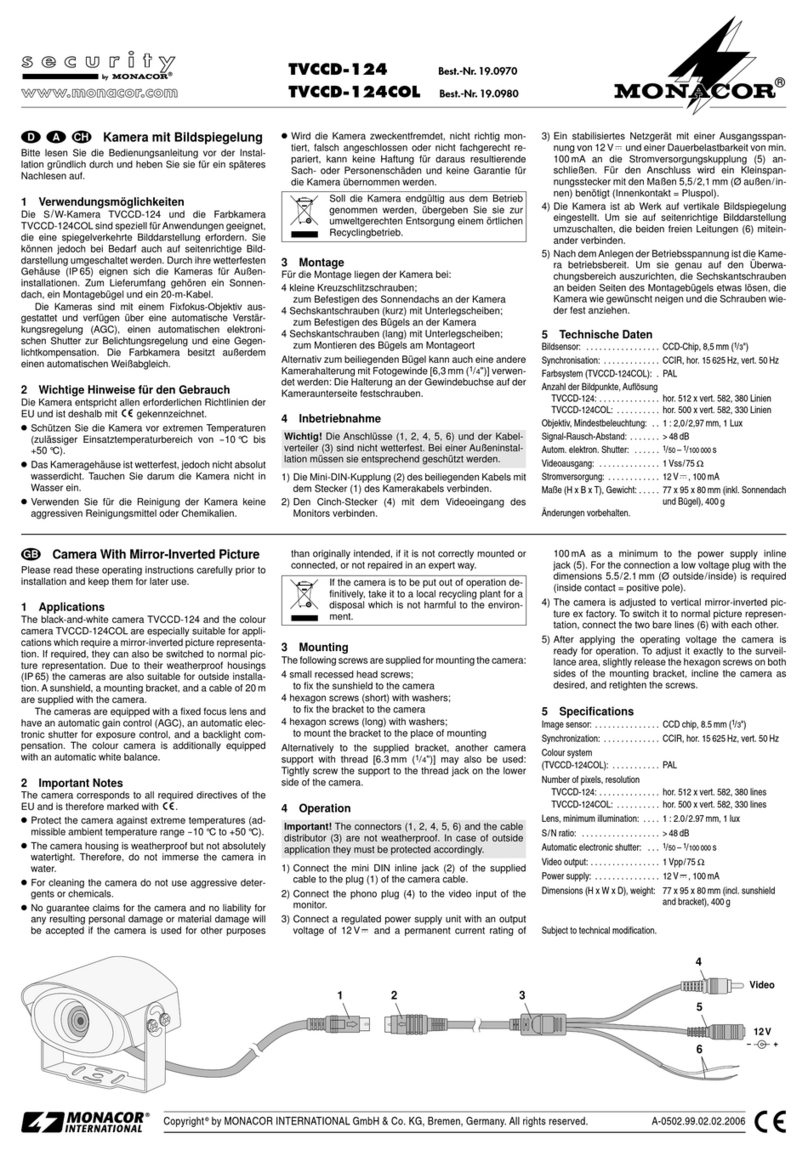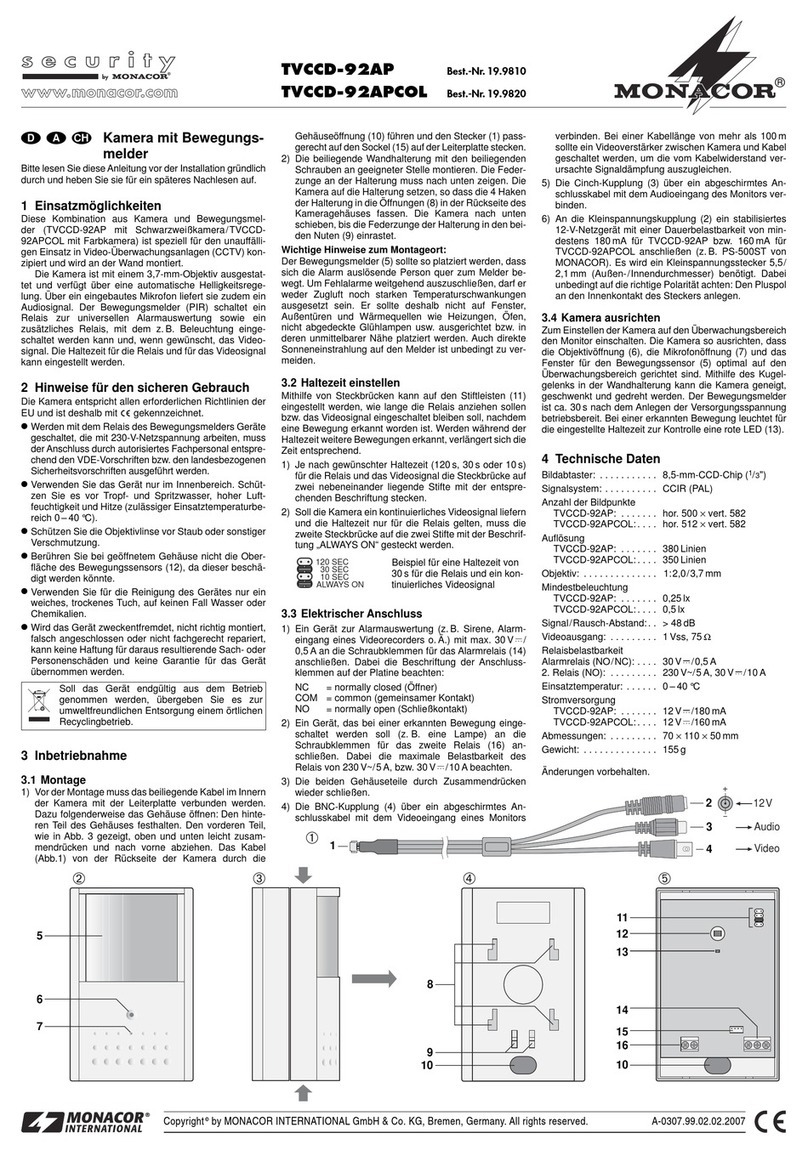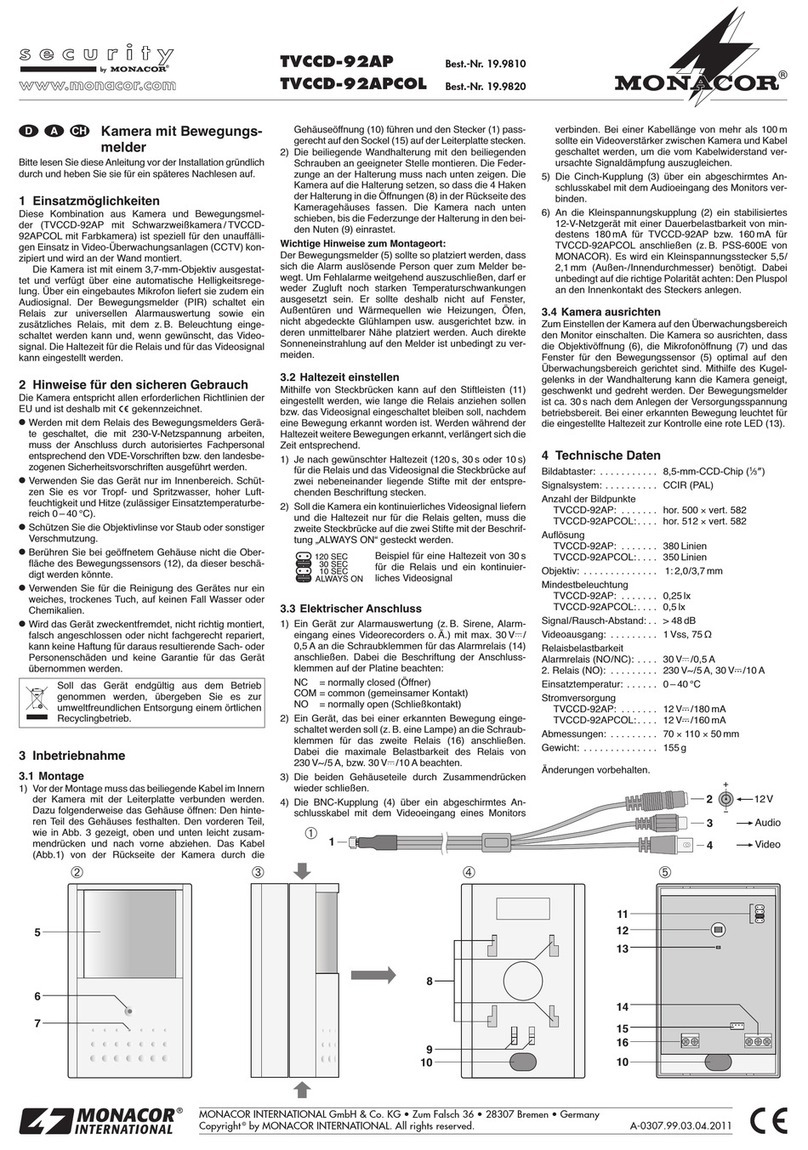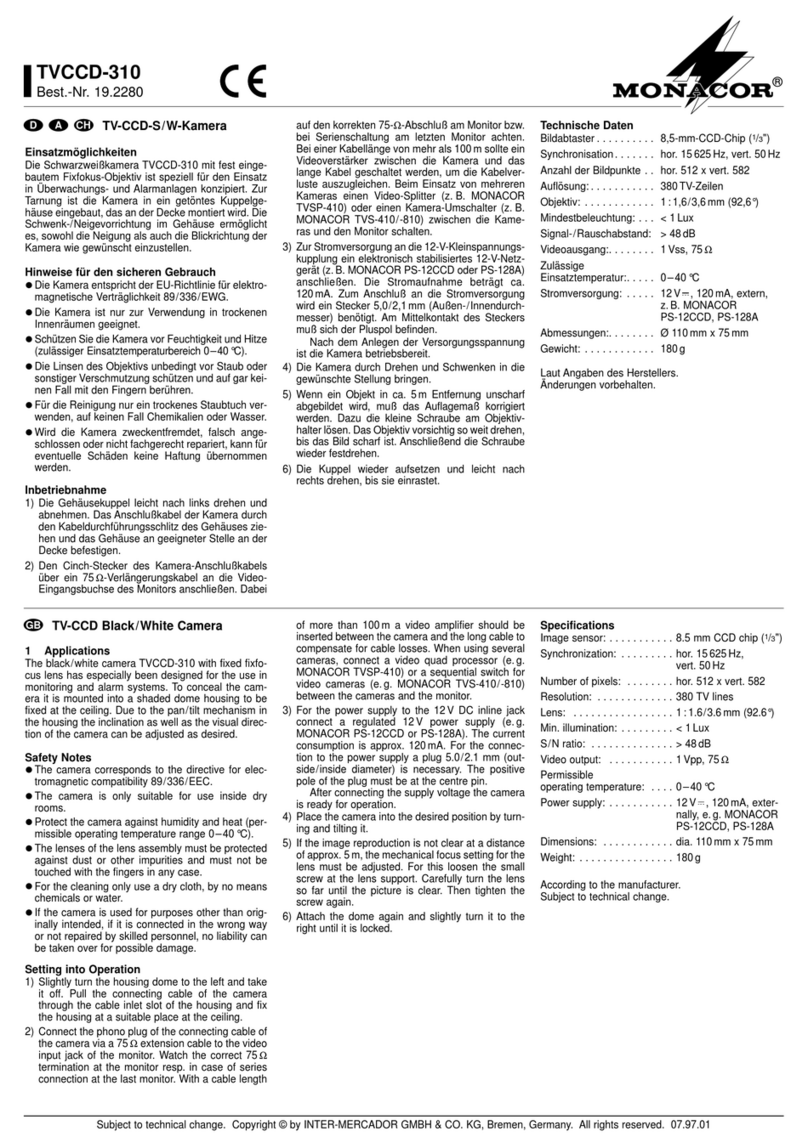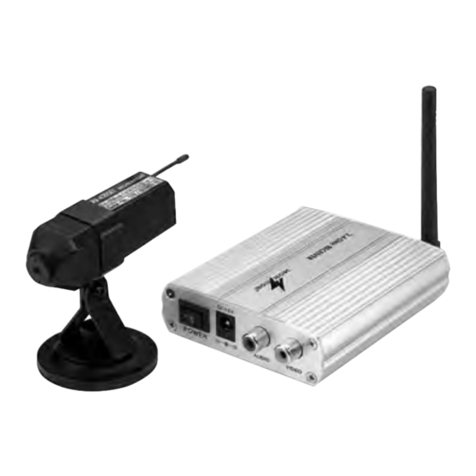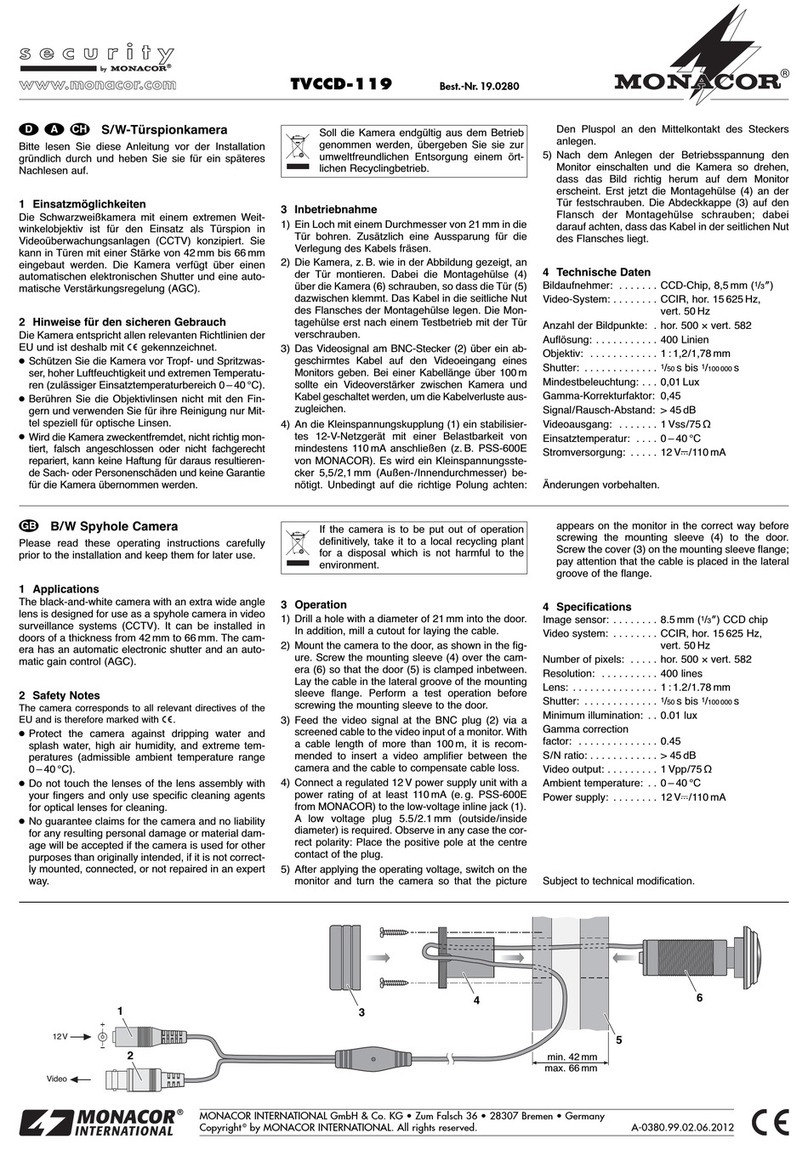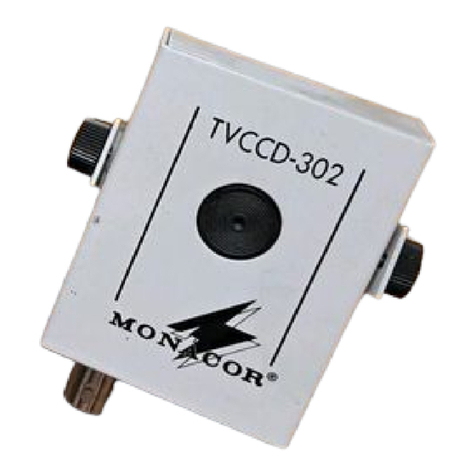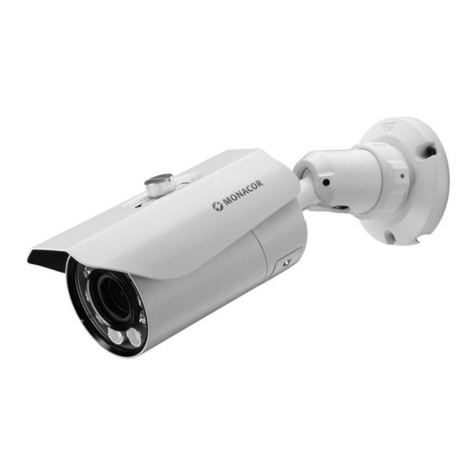CARACTERISTIQUES TECHNIQUES
Image sensor : Vidicon
Synchronisation : Vert. 50 Hz / Hor.15 625 Hz
Résolution : 550 lignes
Luminosité minimale : 20 lux
Largeur de bande
de l’ampli vidéo : 9 MHz
Sortie vidéo : 1 Vcc/75 Ω, BNC
Objectif : filetage C-Mount
Température d’utilisation : -15°C à + 50°C
Alimentation : 230 V, 50 Hz, 8 VA
Dimensions (LxHxP) : TVC-500: 95 x 70 x 260 mm
TVC-600: 110 x 75 x 245 mm
Poids : TVC-500: 1.38 kg
TVC-600: 1.5 kg
d’après les données du constructeur
tout droit de modification réservé
CAMERA NOIR & BLANC
A lire, s. v. p., avant première utilisation!
Les caméras TVC-500 & TVC-600 sont des caméras Noir &
Blanc conçues pour une utilisation universelle comme
caméras de surveillance avec un moniteur vidéo.
D’une utilisation très simple, il est également possible de
leur adjoindre tous les objectifs standard grâce au
filetage international C-Mount.
MONTAGE
Installez la caméra dans un endroit offrant un vaste
champ de vision: ne l’exposez pas à une source de
lumière forte comme le soleil ou des surfaces
réfléchissantes.
Attention: les tubes vidicon peuvent brûler: protégez
donc l’appareil de l’humidité, des températures trop
élevées ou trop faibles et des chocs.
ATTENTION
Cet appareil est soumis à des tensions de 220 - 240 V.
Ne touchez jamais l’intérieur de l’appareil car, en
cas de mauvaise manipulation, vous pourriez subir
une décharge électrique mortelle.
Faites plutôt appel à un spécialiste.
BRANCHEMENTS
Une fois la caméra et le moniteur installés, reliez-les
entre eux avec un câble coaxial 75 Ω(par exemple VCC-
59 ou RG-59 B/U); utilisez une prise BNC sur le côté de la
caméra.
Il faut brancher le moniteur sur du 75 Ω. Si, comme
indiqué sur le schéma, plusieurs moniteurs sont branchés
en série, il faut tous les commuter sur une entrée forte
impédance: seul le dernier est branché sur du 75 Ohms.
MISE EN SERVICE
Allumez l’alimentation de la caméra et du moniteur.
Vous pouvez régler le contraste et la luminosité sur le
moniteur en mettant le potentiomètre sur la position
médiane. Fixez l’objectif puis ôtez le cache et orientez-le
vers la zone à surveiller.
Tournez ensuite le réglage B (situé sur la face arrière de
la caméra) vers la droite dans le sens des aiguilles d’une
montre jusqu’à ce que l’image soit bien visible.
Il convient maintenant de régler la résolution
sur la caméra:
mettez l’objectif sur l’infini, placez un objet à une
distance de 8 à 10 m, à partir duquel vous allez régler la
résolution.
Pour un réglage approximatif mécanique, utilisez un
tournevis et insérez-le dans le trou DISTANCE situé sous
l’objectif sur la face avant.
Les tubes de prises de vue sont déplacés: on peut ainsi
obtenir une résolution correcte.
Le réglage fin se fait électriquement avec le réglage F
situé sur la face arrière de la caméra.
Pour une meilleur image, vous pouvez régler également
le contraste et le faisceau.
CONSEILS
En cas de non utilisation prolongée, n’oubliez pas de
débrancher la caméra et de remettre le cache sur
l’objectif. Pour des températures inférieures à 15°C ou
supérieures à 50°C, la restitution de l’image se dégrade.
Nous vous conseillons d’utiliser un boîtier de protection
pour des températures basses, voire un système de
chauffage (TVG-365 avec TVG-366 ou TVG-400).
De par la conception particulière des tubes vidicon
employés, il est possible, lorsque vous changez
rapidement de caméra, que l’ancienne image apparaisse
encore à l’écran.
TELECAMERA B/N
ILeggere prima dell´uso!
Sono due telecamere b/n di differente aspetto, per
impiego universale nei sistemi di sorveglianza con
monitoraggio video.
Facilissime da usare in quanto prive di comandi; la
tecnica modulare permette una manutenzione agevole.
Grazie alla filettatura C-mount è possibile montare tutti
gli obiettivi correnti.
MONTAGGIO
Sistemare la telecamera in un punto dal quale si vede
bene tutta la zona da sorvegliare, evitando che sorgenti
di luce, come il sole o superfici riflettenti, siano rivolte
direttamente verso la telecamera.
Altrimenti il tubo vidicon potrebbe subire dei danni.
Proteggere la telecamera dall’umidità, da temperature
troppo alte o troppo basse e dagli urti.
ATTENZIONE!
All’interno di questo apparecchio si trova della
corrente di rete 220 - 240 V.
Non intervenire mai al suo interno; la
manipolazione scorretta può provocare delle
scariche pericolose.
Per l’assistenza, rivolgersi all’esperto.
COLLEGAMENTO
Dopo aver collocato la telecamera ed il monitor, si
provede ad unire i due apparecchi con un cavo coassiale
75 ohm (p. es. MONACOR VCC-59 oppure RG-59 B/U). Sul
lato della telecamera si usa il connettore tipo BNC.
Regolare il monitor finale su 75 Ω. Se si usano più
monitor in serie, come dall’illustrazione, occorre
regolare l’ingresso di tutti ad alta impedenza, e soltanto
l’ultimo sarà con 75 Ω.
MESSA IN FUNZIONE
Per la messa in funzione attivare l’alimentazione per la
telecamera e per il monitor. Sul monitor, portare i
regolatori della luminosità e del contrasto in posizione
centrale. Togliera la protezione dall’obiettivo ed
indirizzare la telecamera verso l’oggetto o la zona da
sorvegliare.
Girare il potenziometro B, posto sul retro
della telecamera, leggermente in senso orario, verso
destra, finché l’immagine diventi appena visibile.
A questo punto regolare il fuoco sulla telecamera.
Posizionare l’obiettivo quasi sull’infinito e cercare un
oggetto a 8 - 10 m di distanza per eseguire la messa a
fuoco. La regolazione grossolana meccanica avviene con
l’aiuto di un cacciavite a croce che si inserisce nel foro
DISTANCE sul lato anteriore della telecamera. In tal
modo si sposta il tubo catodico in avanti o indietro fino
al raggiungimento di un’immagine a fuoco.
La regolazione fine avviene elettricamente con il
regolatore F posto sul retro della telecamera.
Gli altri regolatori servono per il contrasto e per la
corrente beam.
Alcuni consigli:
Disattivare la telecamera se non viene usata; nel caso di
disattività prolungata proteggere l’obiettivo con
l’apposita protezione. La ripresa non sarà corretta con
temperature sotto i -15°C. e sopra i +50°C. Per le
temperature sotto zero si consiglia l’uso di un
contenitore protettivo, eventualmente con
riscaldamento (p. es. MONACOR TVG-365 con TVG-366
oppure TVG-400).
La particolare struttura del tubo Vidicon fa si che nel
caso di spostamenti veloci della telecamera, l’immagine
precedente possa rimanere visibile per un breve tempo;
ciò è assolutamente normale.
WARNING!
This unit uses lethally high voltage. To prevent
a shock hazard do not open the cabinet.
Servicing should be done by authorized per-
sonnel only.
CONNECTION
After setting up the camera and the monitor, both
are connected with each other with a 75 Ωcoaxial
cable (e.g. MONACOR VCC-59 or RG-59 B/U), at the
camera a BNC plug has to be used.
The monitor has to be set to 75 Ωtermination. If
several monitors are connected in series, all of them
have to be set to high impedance input, except the
last monitor of the series which has to be set to
75 Ωtermination.
SETTING INTO OPERATION
For operation the power supply for the camera and
monitor/s is switched on. At the monitor brightness
and contrast controls are set to mid-position. The
protective cap is removed from the mounted lens
and the camera is adjusted to the monitoring area
resp. object. Then the trim control B at the rear side
of the camera is slowly turned clockwise until the
picture is just visible.
Now the sharpness has to be adjusted at the camera:
The lens is focused close to infinity and then an
object at a distance of 8-10 m is focused. For mecha-
nical coarse adjustment the camera tube is moved
forward or backward by means of a Philips head
screw driver which is carefully put through the hole
DISTANCE at the camera front side below the lens.
By this a good sharpness is reached at the monitor.
The fine adjustment is electrically made with the F
control at the camera rear side.
Here for best picture representation the contrast as
well as the beam current (operating threshold) can
be adjusted.
Some remarks:
If the camera is not in use, it should be switched off.
If it is not in use for a longer time, the protective
cap should also be mounted at the lens. The picture
reproduction is no longer correct at temperatures
below -15°C or above +50°C, in case of very low
temperatures a weatherproof housing, maybe even
with heating, is recommended (MONACOR TVG-365
with TVG-366 or TVG-400).
Due to the special construction of the vidicon tube,
with the camera quickly moved, it is almost normal
that the previous picture is afterglowing for a short
time.
DATI TECNICI
Sensore ottico : Vidicon
Sincronizzazione : vert. 50 Hz / oriz. 15625 Hz
Risoluzione : 550 righe
Luce minima : 20 lux
Banda video : 9 MHz
Uscita video : 1 Vpp/75 Ω, BNC
Obiettivo : C-mount
Temperatura di esercizio : -15°C. fino a +50°C.
Alimentazione : 230 V, 50 Hz, 8 VA
Dimensioni (l x h x p) : TVC-500: 95 x 70 x 260 mm
TVC-600: 110 x 75 x 245 mm
Peso : TVC-500: 1,38 kg
TVC-600: 1,50 kg
Dati forniti dal costruttore.
Con riserva di modifiche tecniche.
SPECIFICATIONS
Image sensor : Vidicon
Synchronisation : vert. 50 Hz/hor. 15625 Hz
Resolution : 550 lines
Minimum illumination : 20 lux
Video bandwidth : 9 MHz
Video output : 1 Vpp/75 Ω, BNC
Lens : C-mount
Operating temperature : -15°C up to +50°C
Power supply : 230 V, 50 Hz, 8 VA
Dimensions (WxHxD) : TVC-500: 95 x 70 x 260 mm
TVC-600: 110 x 75 x 245 mm
Weight : TVC-500: 1,38 kg
: TVC-600: 1,5 kg
According to the manufacturer. Subject to technical change
